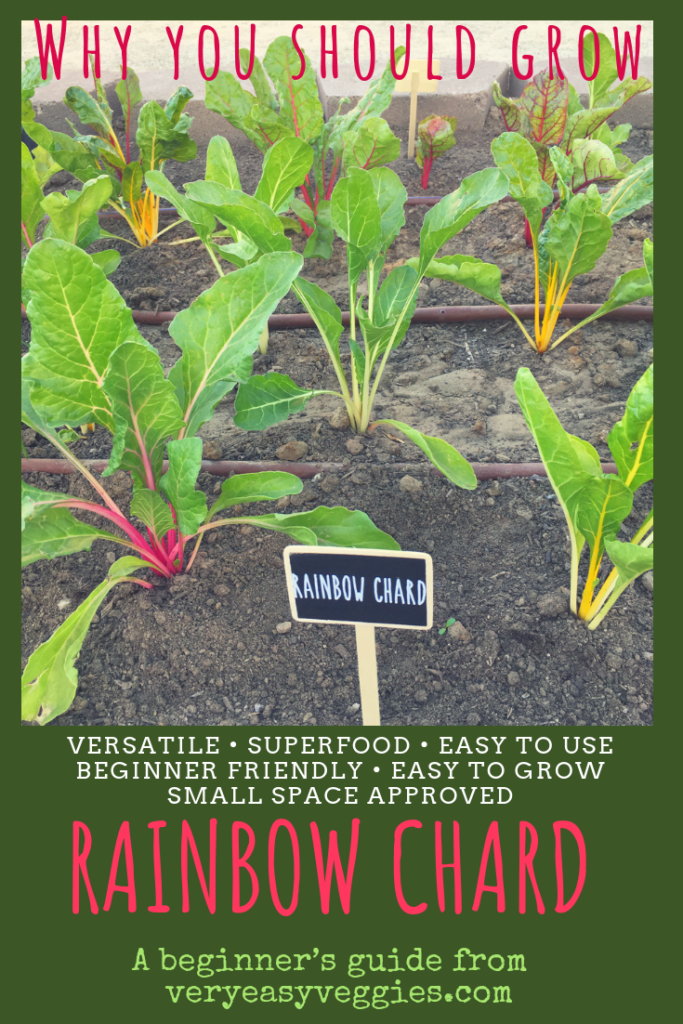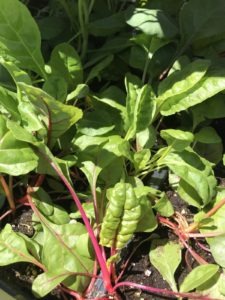Looking for a highly nutritious vegetable that is great for all growers, no matter how much space or growing experience you have?
Swiss chard is a versatile, pretty, and easy-to-grow vegetable that is a great option for beginners. It has great health value and can easily be grown in pots, even if sunlight is too limited for other veggies. It is generally considered a cool season vegetable and can tolerate somewhat colder temperatures. However, the right variety can also do fine in summer if conditions are right. Stems of white, as well as neon pink, yellow, orange, and red are available for extra eye-catching color.
Chard is great for:
- Small spaces & containers
- Limited sunlight
- Beginners – Easy to grow
- a variety of culinary uses
- very easy preparation & cooking
- Survives a variety of weather
- Edible landscaping / visual interest & color
- Excellent nutrient density & nutritional value
Uses for Chard
In general, you can think of chard as a substitute for spinach in just about any use. Using chard can be as easy as tearing off a few leaves (removing stems as needed) and tossing them in the soup pot or smoothie blender! If picked when leaves are young, small, and tender, it can be used as a salad green and is often found in spring mix.
Larger leaves are great cooked in soups or side dishes, and leaves of any size can be used fresh in smoothies. In my opinion, the large size of chard leaves actually makes them easier to clean and chop than spinach. The stalks or thicker leaf veins can be cooked and eaten as well, but I personally don’t prefer their celery-like texture.
Similar to spinach, one may occasionally notice a slight gritty texture on the tongue or teeth when eating chard. This is typically avoided by using it when freshly picked and crisp-tender. Honestly though, I think the sensation is less noticeable in chard than in spinach.
Nutrition information
According to WebMD, “Swiss chard is a nutritional powerhouse — an excellent source of vitamins K, A, and C, as well as a good source of magnesium, potassium, iron, and dietary fiber.” Like some other leafy greens (kale, etc) it’s best to eat in moderate amounts, especially if prone to kidney stones. (More info on that here.)
Growing tips
Decide where you’ll be planting your chard, and whether you’ll buy young plants at a garden store or start them from seed. Chard needs at least a few hours or half a day of sunlight to grow best, but it’s worth a try even if not. Too much heat may make chard turn bitter and “bolt” (go to seed) so provide some shade if needed. Recommended spacing for chard is about four plants per square foot.
If you’re growing in a pot or container, it should be at least a gallon in size, or more if you’re growing multiple plants. Roots don’t go too deep, so a shorter wider container works fine. Self watering planters or pots are a great way to help make sure your plant gets the steady moisture levels it needs to thrive.
Wherever you plant, good soil is essential for good growth (don’t just grab some dirt from your yard!) For pots or containers you’ll need “potting mix”, and some fertilizer if your soil doesn’t contain it already. Chard does best with a fertilizer that is higher in nitrogen (first of the three numbers) since it is grown for leaves, not fruit. Apply fertilizer when plants are young (follow package instructions to avoid harming plants), and again later if they need another boost.
If you’re starting from seed, plant them when soil temperature is at least 40 degrees Fahrenheit (86* is optimum). You can plant directly in the pot or garden, or in a smaller seed-starting container. Don’t plant the seeds too deep, and always keep the soil wet but not too soggy. Be careful not to damage the sprouts as they grow.
Harvesting
Harvest leaves after 4-6 weeks or at desired size (smaller for salad, or large for soups, sides, and smoothies). Harvest the outer leaves first, and let the smaller inner leaves continue to grow for later. This way you can harvest little by little throughout the season.
Have you tried growing or cooking chard? Let us know your experience in the comments!
Stay tuned for more “spotlight” posts on other plants that are great for beginners! Follow along on social media below, or by email using the comment form on any post.


